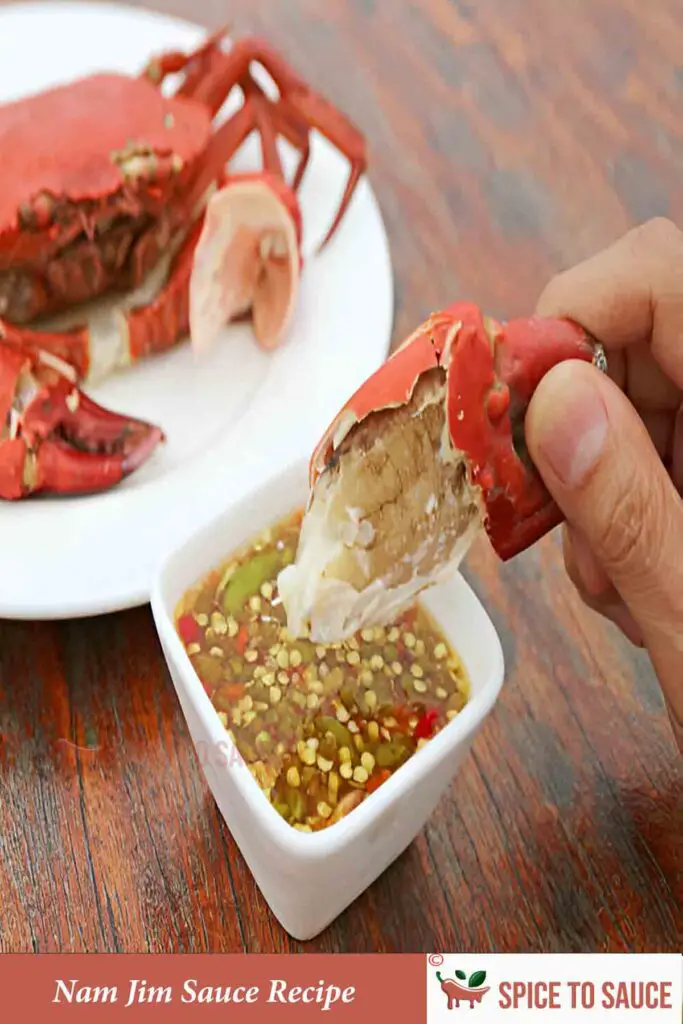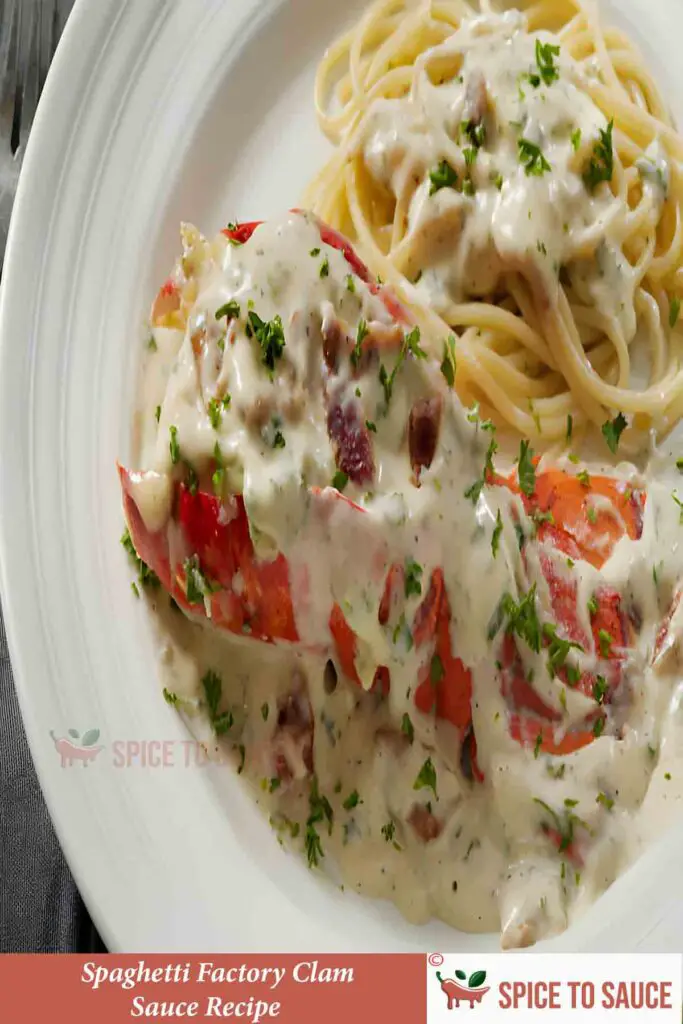Are you a fan of Thai cuisine and looking to add some flavor to your dishes? Look no further than Nam Jim sauce! This versatile and zesty condiment is a staple in Thai cooking, known for its fresh and vibrant taste that can elevate any dish.
Here I’ll dive into the world of Nam Jim sauce, exploring its traditional ingredients, preparation methods, and the best dishes to pair it with. Whether you’re a seasoned chef or just starting out in the kitchen, this recipe will surely become a favorite in your culinary repertoire. So grab your ingredients and get ready to whip up a batch of delicious Nam Jim sauce to impress your taste buds!

What is Nam Jim Sauce?
Many Thai cuisines are based on nam jim, a Thai phrase meaning “dipping sauce.” This basic nam jim sauce (or dressing, as the two terms are typically used interchangeably) is commonly served with grilled or steamed fish. It includes sugar (often palm sugar), chiles, garlic, fish sauce, lime juice, and fish sauce. The components can be finely chopped or mashed using a mortar and pestle.
You can vary the flavor of different types of nam jim by adding or swapping out ingredients. As an example,
- Nam Jim Jaew (with green onions or shallots and toasted rice powder)
- The thicker and sweeter nam jim gai is frequently served with chicken.
- Ajaad ora jaat (which contains cucumber)
There are several Thai sauces that can be prepared; these are only three examples. Both the simple recipe and the one pictured here can be used to make a variety of sauces, dress salads, or dip meats or fish in. The sauce is really thin; it’s not sticky.
Key Ingredients for Nam Jim
Nam Jim, a versatile Thai dipping sauce, is known for its bold flavors and aromatic ingredients. With some simple ingredients you can make this thai sauce easily.
Long Red Chilli 1
The vibrant color and intense heat of the long red chili add a spicy kick to the sauce, while also infusing it with a rich depth of flavor.
Garlic 4 Cloves
Garlic adds a pungent and aromatic flavor to the sauce. The strong flavor of garlic helps to balance out the tanginess and spiciness of other components in Nam Jim.
Hot Dried Chilli Flakes ½ Teaspoon
These fiery flakes add a punch of heat to the sauce, balancing out the sweetness and acidity of the other ingredients.
Lime Juice ¼ Cup
Lime juice brings a bright acidity to Nam Jim that balances out the savory and spicy elements of the sauce. Its zesty and citrusy notes add a burst of freshness to complement the dish it accompanies.
White Sugar ¼ Cup
White sugar adds the necessary sweetness to Nam Jim, complementing the tanginess of lime juice and the heat of chili peppers. It helps mellow out the sharp flavors and ties everything together harmoniously.
Fish Sauce 2 Tablespoon
Fish sauce is a staple in Thai cuisine, known for its rich umami flavor. Made from fermented fish and salt, fish sauce provides a savory depth to the Nam Jim sauce that complements the other ingredients perfectly.
Fresh Coriander 1 Tablespoon
Its vibrant flavor and aromatic profile add a refreshing and zesty element to the sauce, enhancing its overall taste. Fresh coriander not only provides a burst of freshness but also contributes to the sauce’s vibrant green color, making it visually appealing as well.
How to Make Nam Jim?
Making Nam Jim dressing is quite simple. You may either get your mortar and pestle and get to work, or you can chop the ingredients up like I did here. It only takes a few minutes to make a delicious Thai dressing that you can drizzle over salads or dip in.
Get the Ingredients Ready
First, finely cut the fresh chilies, coriander, and garlic. To save time, I use a mincer to chop the garlic. Squeeze the lime and then mix everything together.
Mix Everything Together
If you have a mortar and pestle, just throw everything in and mix it up! If you’re chopping your ingredients, grab an old jam jar or a mason jar, like I do, and toss everything right in. Put the lid on and give it a good shake to incorporate the sugar in. Simply toss it in a bowl and mix thoroughly. All set!
Foods That Pair With Nam Jim
Here are some classic recipes that can be enjoyed with nam jim jeaw:
- Thai barbecue chicken, often known as gai yang, is a delectable dish. This is a favorite in my house, and the chicken may also be baked.
- Steaks on the grill. We’re so into it that some Western steakhouses serve nam jim jeaw with gravy because certain Thais (myself included) simply can’t eat meat without it!
- Pork jowl on the grill.
- Northeastern Thai hotpot, often called jim jum or jeaw hon. Because the parts are delicate, we use the lighter jaw for this one.
- I absolutely adore crispy pig belly, especially when combined with jeaw. It effectively balances the fat, allowing you to enjoy it without feeling too greasy. I’d recommend going with the light version for this one.
Nam Jim Variations
Nam jim jeaw is more of a feeling than a precise recipe. on improve the food’s compatibility, people adjust the ingredient ratios according on what is being served. Two distinct restaurants’ nam jim jeaw is rarely the same!
Original All-Purpose Jeaw
If you’re undecided, this is the go-to option. It’s a tasty combination of salty, sour, and sweet that goes well with almost everything, particularly BBQ chicken, steak, and pork jowl. It has a good thick texture and will adhere to meats quite nicely when dipped.
Light Jeaw
It’s lighter and has more lime juice, so it clings perfectly to meats when dipped. Ideal for the thin, delicate bits of meat found in hot pot. It’s less sweet and has a great sour and salty edge, which helps to balance off the richness of fatty meats like pig belly or anything overly sweet.
Mellower Tomatoes Jeaw
The original jeaw is really intense, thus rookie players may overdo it. I made a chilled version by adding diced tomatoes, which people can easily shovel onto their meat.
FAQ
What is the Difference Between Nam Jim and Nam Prik?
Nam jim is similar to nam prik. This one is similar to the one you see above, except it’s a little chunkier because nam prik typically contains shallots. It may or may not contain sugar.
Is Nam Jim Dressing Spicy to Eat?
Yes, there are chiles, but you can adjust the heat. My rendition is displayed here from what I would describe as a medium heat level. You can add as much or as little chilli spice as you like because this is really a “to taste” recipe. If you don’t like a lot of heat, throw away the seeds from the chilies; this will also assist to cut the dried chillies.
What Does Nam Jim Sauce Taste Like?
Thai chili sauce made in the Isaan way, called Nam Jim Jaew, has a great mix of smokiness, spice, sweetness, and sourness. This dish has all of the things that people love about Thai food in one bowl. You can find this Thai dipping sauce on every street corner in Thailand because it is easy to make and only needs a few simple ingredients.
Where is Nam Jim from?
Nam jim sauce is a classic Thai chili dipping sauce. It is acidic, salty, spicy, and somewhat sweet, demonstrating extraordinary adaptability and simplicity of preparation. Nam jim dressing, or nam jim sauce, is a tasty Thai chili dipping sauce.

Nam Jim Sauce Recipe
Ingredients
- 1 Long Red Chilli
- 4 Cloves Garlic
- ½ Teaspoon Hot Dried Chilli Flakes
- ¼ Cup Lime Juice
- ¼ Cup White Sugar
- 2 Tablespoon Fish Sauce
- 1 Tablespoon Fresh Coriander
Instructions
- Cut the red chili finely
- Although nam jim sauce has a hot taste sensation, you can control the heat level by saving the seeds and adding them slowly after tasting
- Combine in a mason jar the minced garlic, chopped chile, chili flakes, lime juice, sugar, fish sauce, and coriander
- Before use, make sure you really shake
Nutrition
Final Words
Enhance your culinary skills with the flavorful Nam Jim sauce recipe. This versatile sauce is a perfect combination of sweet, sour, spicy, and savory flavors that can elevate any dish to new heights. Whether you’re a seasoned chef or just starting out in the kitchen, adding this sauce to your repertoire will surely impress your taste buds and those around you. So why wait? Get ready to tantalize your senses and embark on a delicious gastronomic adventure with the Nam Jim sauce recipe today!




